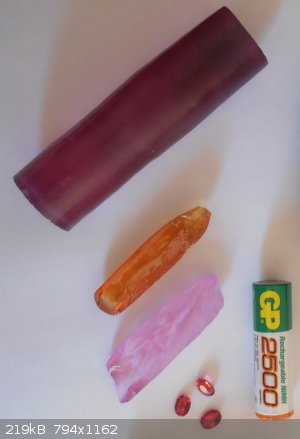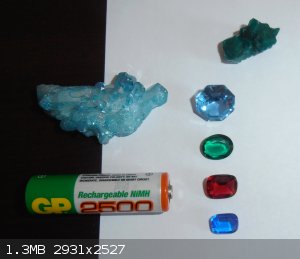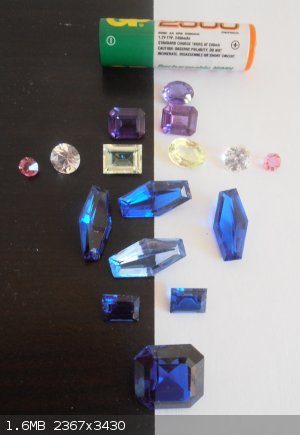bluemike
Harmless

Posts: 4
Registered: 27-1-2009
Member Is Offline
Mood: No Mood
|
|
synthetic corundum
I bought an old 1970's METCO metallizing gun secondhand and starting mixing up my own powder mixes and trying them out. I've made some neat gemstone
coatings with aluminum powder. I have a book called Gemstones Made by Man(Nassau) that describes Verneuil's flame fusion torch. I've tried to make
a fused boule like his process, but can only make small crystals. I'm using oxy-acetylene and his torch used oxy-hydrogen. I wonder if the hydrogen
makes a difference? I've noticed that copper powder makes the flame smoke and make lampblack, even when the flame is oxidizing. Why is this? Does
anyone have experience with this?
|
|
|
DJF90
International Hazard
    
Posts: 2266
Registered: 15-12-2007
Location: At the bench
Member Is Offline
Mood: No Mood
|
|
I dont think you are making lampblack, but rather copper (II) oxide, which is a black powder. It could form from oxidation of the copper metal in the
oxidising flame. I dont think the oxy-fuel system matters, as an acetylene torch can reach ~2700C IIRC, which should be more than enough (possibly
more than an oxy-hydrogen torch, I dont know). Try heating a smaller amount of material, as you might not be supplying enough energy with a larger
amount.
|
|
|
Xenoid
National Hazard
   
Posts: 775
Registered: 14-6-2007
Location: Springs Junction, New Zealand
Member Is Offline
Mood: Comfortably Numb
|
|
Congratulations bluemike, I've often thought of trying this myself.
Are you using aluminium powder or alumina (Al2O3) powder. The Verneuil process calls for alumina powder sprinkled into the flame. The small melted
particles are allowed to build up on an alumina rod to form to form the boule. Alumina melts at 2050 oC. One advantage of the oxy-hydrogen flame
besides being slightly hotter (2800 oC) would be the lack of contaminants. You may be getting carbides forming which disrupt the corundum crystal
lattice.
|
|
|
not_important
International Hazard
    
Posts: 3873
Registered: 21-7-2006
Member Is Offline
Mood: No Mood
|
|
While reading on the layers and inclusion in corundum made using the Verneuil process, I came across a statement that the bubbles were a result of the
top layer of the boule actually boiling and capturing small amounts of gas as a result.
As the bp of Al2O3 is just about at the limit of the oxyhydrogen flame, this suggests that the top of the boule and falling drops are really hot,
perhaps so fluid that the drops are very fluid and quickly spread out into thin films - the layers seen in the boule. Further assumption is that this
spreading widens the boule from the tiny starting bit to the larger boule diameter.
|
|
|
hissingnoise
International Hazard
    
Posts: 3940
Registered: 26-12-2002
Member Is Offline
Mood: Pulverulescent!
|
|
Fascinating subject, though I must admit, at first glance, I thought corundum in the title was a miss-spelling of conundrum.
Correct me if I'm wrong, but isn't ruby simply corundum coloured by chromium.
This gives me one more reason to buy an oxyacetylene torch.
I think, btw, that the oxyacetylene flame is hotter than oxyhydrogen and was one reason oxyacetylene became ubiquitous for cutting and welding.
Now, where are my reading glasses. . .
Homemade emery-paper, bluemike???
|
|
|
hissingnoise
International Hazard
    
Posts: 3940
Registered: 26-12-2002
Member Is Offline
Mood: Pulverulescent!
|
|
| Quote: | Originally posted by Xenoid
You may be getting carbides forming which disrupt the corundum crystal lattice. |
Good point, Xenoid, CO2 may be unstable above 2000*C, which might make C2H2 a poor choice in this instance.
Back to the DB. . .
|
|
|
Fleaker
International Hazard
    
Posts: 1252
Registered: 19-6-2005
Member Is Offline
Mood: nucleophilic
|
|
Oxy-acetylene is indeed hotter than oxy-hydrogen. Nice thing about O2/H2 is that it's a very clean flame. I always wanted to try the Verneuil process.
Please post up some pictures of the boules you make and your setup.
Neither flask nor beaker.
"Kid, you don't even know just what you don't know. "
--The Dark Lord Sauron
|
|
|
PHILOU Zrealone
International Hazard
    
Posts: 2893
Registered: 20-5-2002
Location: Brussel
Member Is Offline
Mood: Bis-diazo-dinitro-hydroquinonic
|
|
Here is the little a know about the problem...
I rememeber a TV document (a few 14 years ago) that explained that an american society was specialised into the making of synthetic corundum...Their
stones where pure and in cristaline shapes, bubbleless, usefull for optical lenses and devices, ranking over the 1 cm diameter...loked like a candy
store  ; but the process was electrothermic and with the help of a secret
fundant salt mix (certainly an eutectic that allowed lower mp of the Al2O3)...Synthetical stones so produced were purer than the natural occuring
stones and so they dopped their stones with a specific element that provided orange fluorescence, to distinguish the synthetic stones from the natural
ones...price was attractive though since it was 1/20th of the price of the natural product! ; but the process was electrothermic and with the help of a secret
fundant salt mix (certainly an eutectic that allowed lower mp of the Al2O3)...Synthetical stones so produced were purer than the natural occuring
stones and so they dopped their stones with a specific element that provided orange fluorescence, to distinguish the synthetic stones from the natural
ones...price was attractive though since it was 1/20th of the price of the natural product!
This gave me the idea to try the making of corundum...
I also have a tiny butane-N2O torch, and a larger Butane-O2 torch with what I was able to make some red ruby pellets (1mm diameter) from Al2O3 white
powder and a little green Cr2O3. But with a torch the amount of powder sprayed arround by the gases is big...The container was heat resistant clay in
a cup fashion so that the pellets fall back into the melt.
-Al2O3 gives leuko corundum (colourless stone)
-With a little Fe2O3 gives yellow corundum
-With a little Cr2O3 gives the red corundum (ruby)
-With a litlle TiO2 or FeO gives a pale blue corundum
-With a little CoO gives a deep blue corundum (saphire)
So with red-blue-yellow and colourless, one can make a rainbow of corundum...
One might think to use instead of the electricfurnace a sunlight laser (2000-4500°C) furnace to get bubbleless stones...
I hope this helped
PH Z (PHILOU Zrealone)
"Physic is all what never works; Chemistry is all what stinks and explodes!"-"Life that deadly disease, sexually transmitted."(W.Allen)
|
|
|
12AX7
Post Harlot
    
Posts: 4803
Registered: 8-3-2005
Location: oscillating
Member Is Offline
Mood: informative
|
|
I believe synthetic sapphire is made by fusing Al2O3 in a molybdenum crucible (inert atmosphere, induction heated) and drawing a boule through a mask
if noncylindrical shapes are desired.
Synthetic sapphire isn't too hard to come by; they use it for scratch resistance in supermarket checkout scanner windows. Each pane is probably a few
hundred bucks, which considering the size and nature of it, is an excellent deal.
Tim
|
|
|
Saerynide
National Hazard
   
Posts: 954
Registered: 17-11-2003
Location: The Void
Member Is Offline
Mood: Ionic
|
|
Do post pics if you manage to make the boules! It would be awesome if you faceted them 
"Microsoft reserves the right at all times to monitor communications on the Service and disclose any information Microsoft deems necessary to...
satisfy any applicable law, regulation or legal process"
|
|
|
chief
National Hazard
   
Posts: 630
Registered: 19-7-2007
Member Is Offline
Mood: No Mood
|
|
There are several different ways of growing corundum:
==> the Verneul: Rinsing Al2O3-powder down through a downwards-directed H + O-flame
==> the Czochralski: Melting everything, putting a seed in, and pulling that seed slowly out, maybe 1 mm/hour
hight temperature required for the above ways ... ; both give long rods, suitable for laser-applications etc.; but not good for gemstones, because the
dopants don't get distributed evenly
There are 2 chepaer ways too, also bettter for gem-quality; I recently saw a website about that, let me see, if I can find it ...
|
|
|
12AX7
Post Harlot
    
Posts: 4803
Registered: 8-3-2005
Location: oscillating
Member Is Offline
Mood: informative
|
|
Er, dopants get distributed quite evenly. Rubies? Pffbt, imprecise alchemy, Cr2O3 to 1%. Large silicon boules are regularly grown with parts per
trillion doping levels with the Czochralski process.
Tim
|
|
|
Sedit
International Hazard
    
Posts: 1939
Registered: 23-11-2008
Member Is Offline
Mood: Manic Expressive
|
|
| Quote: | | because the dopants don't get distributed evenly |
Are you shore about this? The whole principle that a laser basis it self off of requires that the crystal structure and ESSPECIALY the dopant be in as
precise manner as possible.
|
|
|
chief
National Hazard
   
Posts: 630
Registered: 19-7-2007
Member Is Offline
Mood: No Mood
|
|
The dopants _dont_ get distributed evenly with the verneul, and neither with the czochralski ; no gem-quality possible, but good enough for lasers.
The rods, viewed from the side, always have zonar coloring, paler sections and fuller ones.
Of course a world-champion-crystal-grower might succeed in making this quite invisible, but that takes quite some control at the temperatures of 2100
Celsius ....
It's also the same for the dopants in Si-crystals: This was always a problem, until only several years ago, when it was introduced to
electromagnetically stir the liquid zone .
[Edited on 4-2-2009 by chief]
|
|
|
zed
International Hazard
    
Posts: 2277
Registered: 6-9-2008
Location: Great State of Jefferson, City of Portland
Member Is Offline
Mood: Semi-repentant Sith Lord
|
|
In natural gemstones, growth lines are "geometrical" and parallel to natural crystal faces. These naturally occurring crystals are generally
inferior in superficial appearance, and very few natural stones equal the color and clarity available via the Verneuil or Czochralski processes.
It isn't the presence of growth lines that indicates a gemstone is of artificial origin. More often it is the geometry of those lines. In the
simplest cases, these can be easily observed through a jeweler's "eye piece". The Verneuil process produces beautiful gems, that have obviously
"Curved" growth lines.
Such crystal growth does not occur in nature.
Of course, most artificial "Colored" stones can be readily identified without even an eyepiece.
They look too good!
|
|
|
MessyScience
Harmless

Posts: 1
Registered: 17-10-2015
Member Is Offline
Mood: No Mood
|
|
I'm by no means an expert on the subject, but I am fairly sure that crystals (rubies, emeralds, etc.) that are produced through both flame fusion
(Verneuil) and the Czochralski are gem-quality. They have both been used extensively in "budget" jewelry. One example off of the top of my head is
Stauer. I honestly don't know much about how the dopants are distributed, but apparently they do turn out gem-quality.
So far, it sounds like an oxyhydrogen flame would be needed to avoid carbides and other contaminates.The process traditionally takes place over the
course of multiple hours. I know that there are oxygen tanks available but, in terms of practicality, how would one be able to obtain a supply of
hydrogen large enough to form a flame four several hours?
I guess that your options would essentially be limited to some sort of metal hydride storage, or to a reaction that produced a steady supply of
hydrogen. Electrolysis could be an option.
Any thoughts and other contributions would be welcome. I realize that this is a very old thread, but I hoped that I would be able to find some
information and ideas from those more knowledgable than I. Thanks!
|
|
|
PHILOU Zrealone
International Hazard
    
Posts: 2893
Registered: 20-5-2002
Location: Brussel
Member Is Offline
Mood: Bis-diazo-dinitro-hydroquinonic
|
|
Yes Verneuil corundums (ruby and saphire are corundums) are good for optical and for jewelry.
I bought some pears and cylinder for cheap at a mineral fair/salon and even some facetted gemstones... all Verneuil's
In the picture here under:
-50€ for the big cylinder (it is glassy on that side, but very transparent through the section) color from ruby red to violet
-6€ for the orange half pear
-5€ for the pink half pear
-2-3€ for each facetted rubies

In the following picture:
(-green dioptase from Katanga)
(-pale blue quartz gold aqua (quartz bombed with Gold atoms giving a blueish surfacial color (1mm deep penetration))
-27€ for the facetted pale blue saphire
-23€ for the 3 facetted gemstones (deep green & deep blue saphires and the red ruby)

[Edited on 22-10-2015 by PHILOU Zrealone]
PH Z (PHILOU Zrealone)
"Physic is all what never works; Chemistry is all what stinks and explodes!"-"Life that deadly disease, sexually transmitted."(W.Allen)
|
|
|
PHILOU Zrealone
International Hazard
    
Posts: 2893
Registered: 20-5-2002
Location: Brussel
Member Is Offline
Mood: Bis-diazo-dinitro-hydroquinonic
|
|
Here are my last aquisitions facetted gemstones with Verneuil's process corundums from a mineral fair/salon in Liège (Belgium)..total 115€ very
nice quality
In the picture here Under against a AA Battery for scale reference:
-Top 3 violet corundums/saphires
-2 yellow corundums/saphires embaced by two colourless saphires and on the extremes 2 pink rubies (red saphires)
-Below 7 blue corundums/saphires

I also bought two lasers (one red and one UV).
Interesting feature of red, pink and blue saphires are their bright red-pink fluorescence in the dark when exposed to UV laser/light...
I'll try to make a picture of that fascinating effect. Yeah back into the 80's fluo flash fun 
[Edited on 18-12-2015 by PHILOU Zrealone]
PH Z (PHILOU Zrealone)
"Physic is all what never works; Chemistry is all what stinks and explodes!"-"Life that deadly disease, sexually transmitted."(W.Allen)
|
|
|
Texium
|
Thread Moved
22-11-2023 at 19:57 |